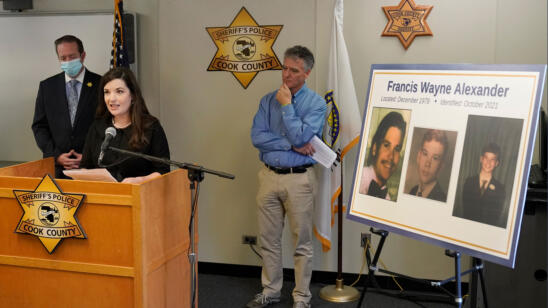In January 1972, Timothy “Tim” McCoy, a blond and affable 16-year-old, vanished while traveling home to Nebraska. More than a decade later, authorities identified him as the first known murder victim of serial killer John Wayne Gacy.
Gacy, the so-called “Killer Clown,” who lived in Norwood Park Township, outside Chicago, Illinois, murdered at least 33 boys and men between 1972 and 1978. Gacy worked as a building contractor and earned his nickname because he performed as a clown at parties, events and even children’s hospitals.
Tim McCoy’s Life and Death
McCoy was among Gacy’s few out-of-state victims, and the only one stabbed to death. Gacy strangled his other victims, most of whom lived locally.
A down-to-earth, gregarious teenager, McCoy was often described as “the life of the party,” says David Nelson, whose book Boys Enter the House explores the lives of Gacy’s victims via interviews with their families and friends. He also was a little mischievous, as teenagers can be, and loved to hitchhike, which in the 1970s was common among youth, Nelson tells A&E True Crime.
“His cousins loved being around him. His grandmother favored him—and she had a whole sea of grandkids to contend with,” Nelson says.
After McCoy’s parents divorced, the boy lived in Nebraska with his father, while his mother lived in Florida with her new husband. The family originally hailed from Iowa, where Tim spent Christmas 1971 alongside his grandparents, cousins, aunts and uncles. Then, he traveled to Michigan to spend New Year’s at the home of relatives.
[Stream episodes of Invisible Monsters: Serial Killers in America in the A&E app.]
On January 2, 1972, McCoy boarded a Greyhound bus to Chicago, where he planned to catch a connecting bus to Nebraska after a 13-hour layover, the Lansing State Journal reported. That’s when McCoy crossed paths with Gacy.
McCoy’s family, who couldn’t be reached for comment for this story, would only learn about his death 14 years later, when his remains were identified.
Police arrested Gacy in 1978, who confessed to authorities that he’d been drinking and driving at night around Chicago when he pulled up to the Greyhound bus station and met McCoy.
According to Gacy, the two drove around and then went to Gacy’s house, where McCoy ate some food and drank some alcohol. Then, according to Gacy, the two had sex. Gacy claimed he then woke up at 4 a.m. to see McCoy with a butcher knife in his hand, walking toward him. The two struggled for the knife, and eventually McCoy fell on it and died, Gacy said.
The autopsy on McCoy’s body also confirmed he’d been stabbed, Nelson says.
Doubts About How Tim McCoy Died
McCoy’s family, however, disputes that McCoy would have gone with Gacy willingly, as well as the description the killer gave about what happened in his house, Nelson says.
Katherine Ramsland, professor of forensic psychology at DeSales University, tells A&E True Crime she, too, doesn’t believe Gacy’s description of how he killed McCoy, or that the two had consensual sex.
Gacy was a psychopath, always narcissistic and confident, which helped him lure victims and later appear credible to authorities, she says. But in reality, “he was a self-serving liar who always blamed his victims,” says Ramsland, whose books include How to Catch a Killer and Confessions of a Serial Killer.
Gacy was arrested in December 1978 following an investigation by police in Des Plaines, Illinois into the disappearance of victim Robert Piest. Gacy confessed to murdering 33 boys and young men, burying most of them in a crawlspace under his house.
Before his confession, two victims who survived his brutality had reported his crimes to police.
Chicago police arrested Gacy in December 1977 after a 19-year-old reported that Gacy kidnapped him at gunpoint and forced him to engage in sexual acts, the Chicago Tribune reported in January 1979. Gacy maintained the sexual acts were consensual and no criminal charges were filed. Three months later, in March 1978, a 27-year-old man reported Gacy had chloroformed him, driven him to his house and sexually assaulted him before letting him go, the Tribune reported. In that case, Gacy was charged with misdemeanor battery.
Complaints against Gacy were “perfunctorily” investigated by police because of bias against his teenage victims, who they assumed were homosexuals, social psychologist Frank Osanka told the Indianapolis Star in 1980. Osanka testified for the prosecution at Gacy’s trial, deeming the serial killer legally sane.
Stigma about homosexuality was widespread at the time, Ramsland says. It was only in 1973 that the American Psychiatric Association removed the diagnosis of “homosexuality” from the second edition of its Diagnostic and Statistical Manual of Mental Disorders.
Plotting in Prison
Before murdering McCoy, Gacy had spent time in prison after being convicted of sexually assaulting a 15-year-old boy in 1967 in Iowa, where he lived at the time. Gacy, who worked as a manager at a fast food restaurant, also hired one of his employees to beat up his victim, in an effort to silence him. Gacy was sentenced in 1968 to 10 years in prison, and was released on parole in 1970.
Then, in 1971, Gacy sexually assaulted a boy he picked up from the Greyhound bus station in Chicago—the same station from which he picked up McCoy a year later. The victim didn’t show up for court, so the charges were dismissed, Nelson writes in his book.
While in prison in Iowa, it’s likely that Gacy spent time plotting how he would commit his next crime with impunity, Ramsland says.
“One thing we know about sexual predators who do not want to go back to prison is that they are going to start terminating their witnesses. They are going to find a way they don’t get caught again,” she says.
Another telling detail was Gacy recounting to investigators that after he killed McCoy, he had an orgasm, Ramsland says. That wouldn’t fit with Gacy’s description of an unplanned murder, in which case he would have been disoriented from sleep and afraid of being attacked, she says.
“If Tim was his first [murder] victim and [Gacy] had an orgasm, it would be as a result of a history of rehearsal fantasies,” she says, adding erotophonophilia is marked by sexual arousal or gratification caused by someone’s death.
When the reality of murdering someone for sexual lust doesn’t match the fantasy, the killer might not feel the urge to murder again. But when reality does match the fantasy, it sets the stage for more killing, Ramsland explains.
Identifying Tim McCoy’s Remains
Most of Gacy’s victims came from the Uptown neighborhood of Chicago and had fragmented families, Nelson says. McCoy’s upbringing was different: His family came from a small town, “where everybody knew everybody,” and remained close despite his parents’ divorce, Nelson says.
In the early days of his disappearance, McCoy’s father hired an investigator to look for his son. After the Gacy case made the news, the family suspected that McCoy might have been among his victims, and an aunt was put in charge of sending his dental records to authorities, Nelson says.
But the aunt never sent the record. She later explained that by saying she wanted to spare her family the horror of knowing the truth, he says.
“It was an act of love, in some ways, not to submit dental records, to preserve that family happiness, and not let the dark in, so to speak,” Nelson says. “I also understand the need for answers and getting so close, and feeling frustrated.”
The identification of McCoy’s remains took place in 1986 after a cousin read a magazine article about Gacy. She contacted authorities and provided them with dental records. His family then rallied to bring McCoy’s remains to Iowa, where he is buried.
Gacy was convicted in March 1980 of the 33 murders. At the time, it was largest number of murders charged to one person in U.S. history. He spent 14 years on death row until he was executed by lethal injection in 1994.
Five of his victims remain unidentified.
Related Features:
John Wayne Gacy’s Victims: Gone, But Not Forgotten
What Was John Wayne Gacy’s Murder Trial Like?
John Wayne Gacy’s Childhood: ‘Killer Clown’ Serial Killer Was Victim of Abuse


